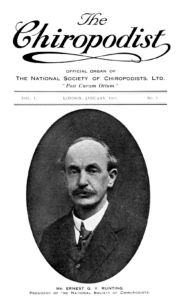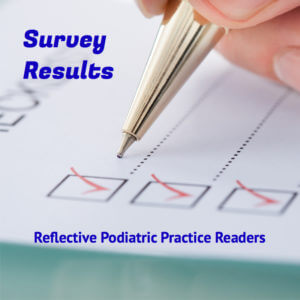Professional Journals – past and present
What does a professional journal mean to you? Is it an important way to stay in touch? A conduit to allow you to learn or publish something of interest. Seemingly journals mean different things to different people. As far back as I can recall, the original journal of my profession came under criticism. ConsultingFootPain explores a little further why journals are a marmite thing. You can also read a recent survey on views about The Podiatrist. See the information at the bottom of this article.

The Podiatrist
“My first journal had been called The Chiropodist. I wrote to the editor applauding the change saying, at last, the profession had made a stand. She would never know what I meant by this unless she understood the protracted mission set out by many of us in seventies Britain.” P.304. Taken from ‘Podiatrist on A Mission’ – first published 2021 and available at Amazon books.
‘The Podiatrist’ is a magazine produced by the Royal College of Podiatrists and kicked off in January 2021. Emma Godfrey, the editor, wrote in January – “Happy first birthday to the podiatrist”. Chris Morriss-Roberts (Professional editor) stated “We have a publication that is useful in showing clinical-based practice as well as sparking debate and discussion.”
With a larger circulation than ‘Podiatry Review’ the journal of the Institute of Chiropodists and Podiatrists– this was the first notable change since the former journal – Podiatry Now (1998) was published although there was a reduction in the number of issues when compared to the former.
My one regret was giving a sizable portion of my journals to a university library where I worked – hence a gap in my resource.
The Chiropodist
 The Chiropodist was in circulation when I joined the London Foot Hospital in 1975 although launched in 1914 (image c/o Dr Ivan Bristow). All students received a generous copy of the then ‘The Chiropodist’ a small journal which covered a wide range of matters – May 1987
The Chiropodist was in circulation when I joined the London Foot Hospital in 1975 although launched in 1914 (image c/o Dr Ivan Bristow). All students received a generous copy of the then ‘The Chiropodist’ a small journal which covered a wide range of matters – May 1987
- Advertising
- Footwear management
- Across the editorial desk
- Obituaries
- A chiropodial survey of elderly persons over 65 year in the community
- Report of Council
- Correspondence
- Book review
- The basic walking aid
Incidentally, after this year the journal enlarged to A4 from A5. The content remained broadly the same but the quality of writing and submission was notable with wider use of referencing.
Dec/1989 recorded an article by a dermatologist (registrar) and S P Kirwan writing on policy making in the health fieldas submitted as part of health BSc Health service study. Keith Rome (today a PhD) was looking at the shock meter instrumentation as part of his BSc.
In an undergraduate degree course, the journal started to reflect on individual research projects. The publication was on merit but anyone could publish which was an important way to expand clinical knowledge and gather evidence. Several matters arose with journal design and concerns for professionalism during the diploma to degree phase. The A4, characteristic of many professional journals would allow for more pages. Produced monthly, members soon had current information, but this expanded to reports of meetings and political changes.
‘The Journal of British Podiatric Medicine’ (JBPM) took over from The Chiropodist with the same cover format – plain with the ‘post curam otium’ Latin inscribed shield, the cover design a half colour and half white appearance. Inside the first page the top line read –
The Journal of
British Podiatric Medicine
The Chiropodist
* Incorporating the British Journal of Chiropody and
the British Chiropody Journal
The British Journal of Chiropody
‘British Journal of Chiropody is a scholarly journal published in the United Kingdom focused on Health & Medical Sciences. This collection contains microfilm published between 1973 and 1979. The ISSN is 0007-0939.’ Archives
The BJC was created and edited by Colin Dagnall, one of the foremost historians of podiatry in the 20th century. Sadly, his attention to historical detail has not been seen since, although later inclusions Gwen French and Don Lorimer should be credited with their valuable contributions.
“The BJC, formerly the British Chiropody Journal, was Dagnall’s independent journal, not formally aligned to any professional body. It was started in 1933 by Frankin Charlesworth, who ran it until the early 1960s (1963), when Colin Dagnall took it over. He kept it going successfully until 1988, when the Society took it and absorbed the title (legally) but ended the publication. Mr Dagnall prided himself on its independence from the Society and other bodies – and it was a very valuable source of information, and captured the mood of the profession in ways the Society’s journal could not, as the latter was, by definition, partisan. I found it hugely helpful when doing my PhD research, and I have a complete collection (electronically now).” (source Borthwick, Alan – PhD thesis & personal communication Aug.2022).
Journal of British Podiatric Medicine
The chief editor was Brian Berry, well known for his exhaustive articles on footwear knowledge, but sadly lacking in today’s education of podiatrists. Footwear pops up now and again but has none of the passion that Brian brought to the pages of The Chiropodist and JBPM. Other editors then included Jim Black, Gwen French, Mike Hobday and Linda Lang. Berry wrote –
“The Foot may be seen as a sister journal to the JBPM, in that it carries articles and papers drafted by members of the Society of Chiropodists and Podiatrists and has state registered chiropodists on its Editorial Committee and on its Editorial Advisory Panel.” December 1993 – The JBPM 48,12:181
The narrative hides the fact that growing concerns had arisen with the quality of several published articles. The key fact is that the JBPM was not a citable journal and had no impact factor. The various search engines could not pick up the contributions being made. Council (SoCAP) at the time recognised the problem and the first issue of ‘The Foot’ came out in 1991 with editors Tom Duckworth and TWD Smith. Both came from orthopaedic backgrounds with their chair Basil Helal, a well-known and regarded orthopaedic surgeon.
The editorial board included radiologists, orthopaedic surgeons, rheumatologists, physicians, plastic surgeons and one chiropodist our own BL Berry. The advisory board, from our own branch, included Robert Ashford (later Professor), HW Reese, Steve West (later Professor), Barbara Wall, R. Winder (N.Zealand), AR Wood amongst other specialities. The strength of the orthopaedic board was notable when compared to the Chiropodists.
The Foot represented a vehicle for papers and was published by Elsevier (then Churchill-Livingstone). The Foot came with a cost, a fact I was made aware of when I joined Council in 1998. Our representation was not as ideal as we would have liked, evidenced by the strong orthopaedic involvement.
The British Journal of Podiatry
The quandary was making our journal more professional and carrying more gravitas. The BJP took off in 1998 with formal guidelines and articles that followed the format that most would regard today as the standard layouts. This was a quarterly journal because a new membership journal was created and overlaid the membership’s needs along the lines of the predecessors – The Chiropodist and the JBPM. Society News appeared in a different page colour
SeaRCh
The Association of Chief Chiropody Officers (ACCO) produced SeaRCh monthly from 1990-1997. ACCO went in a different direction to the then Society of Chiropodists & Podiatrists (the name now included podiatrists) – this was a free resource sent to 6500 State Registered Chiropodists and the name ‘SeaRCh’ was made from SRCh. ‘State Registered Chiropodist’. This included private practitioners, schools of podiatry and lecturers. The editors were R Beech with support from Marcel Pooke and Chris Boden.
ACCO was formed from the NHS’s managerial structure but was all-inclusive and had regular comments from all areas of podiatric (sic) practice. It never shied from politically sensitive comments and was popular, accessible, and dependent on advertising. While companies advertised orthoses, surgery and instrument equipment, SeaRCh had access to advertising jobs in-house whereas before it had relied on other journals. My own bound copy of all these journal magazines holds a veritable quantity of historical archives. Sadly a search of ‘SeaRCh’ shows ACCO registered in the archives but not the magazine.
ADVERT
5th August 1991(p11 as insert) – North Derbyshire Health Authority advertised for a Podiatric Consultant – specialty in Foot Surgery (grade to be determined) 2 sessions per week
Articles were loose and case histories encouraged. Letters sometimes carried quite strong passion – for this was the time of change and the profession was about to be overhauled with amalgamation within the next decade embroiled by disagreement with the British Orthopaedic Association.
Podiatry Now – full colour arrives
Sonia Shepherd was the editor at the time of launch and wrote to all members in 1998.
“Welcome to the first edition of our new monthly journal, Podiatry Now. Those of you who read the December issue of The Journal of British Podiatric Medicine will be aware of the Society’s new publications. Podiatry Now replaces the Society News section of the JBPM and also comprises ACCO journals SeaRCh News and Instep. Podiatry Now is the place for news articles, public appointments, advertisements and reprinted articles. The main body of JBPM containing research articles, along with the PA’s (Podiatry Association) publication British Journal of Podiatric Medicine and Surgery, will combine to form the British Journal of Podiatry which will be produced quarterly…”
Trevor Prior became an editor having served the JBPMS with Tim Kilmartin, Ceibre Carter, Marjorie Maddocks and me. Colour had come to the journal and the pages were glossy and when damp stuck together! From 1998 until 2021 Podiatry Now was the all-time membership journal while the BJP dropped in favour of the Journal of Foot and Ankle Research.
Journal of Foot and Ankle Research
The importance of citable articles became ever apparent to the College of Podiatry which formed from ACCO and the PA between 1996-7. Now the college had 4 Faculties; the thirst for achieving each with their separate needs would have been met by The Foot and BJP, but for reasons mentioned regarding The Foot, the BJP had to stand alone representing our own creative people.
Springer under Biomed Central Ltd took over the College of Podiatry (college) requirements. Together with the Australian Podiatry Association (APA) – a blend of English-speaking podiatrists found a natural home where wide citation searches could be found.
- Cinahl
- Citebase
- Current contents
- DOAJ
- MEDLINE
- OAIster
- PubMed
- PubMed Central
- Science Citation Index Expanded
- SCImago
- Scopus
- SOCOLAR
Podiatry Now was unsaddled with the need for higher-end academic articles but still produced articles with academic rigour and introduced tougher admission criteria along the lines of an academic design.
Journal of Foot and Ankle Research (JFAR) was launched in July 2008 as the official research publication of the Society of Chiropodists and Podiatrists (UK) and the Australasian Podiatry Council, replacing both the British Journal of Podiatry and the Australasian Journal of Podiatric Medicine.
The first article published in 2008 in JFAR was entitled –
Welcome to Journal of Foot and Ankle Research: a new open access journal for foot health professionalsAuthors: Hylton B Menz, Mike J Potter, Alan M Borthwick and Karl B Landorf Citation: Journal of Foot and Ankle Research 2008 1:1. Editorial Published on 28 July 2008. JFAR is published by BioMed Central (now BMC), one of the pioneers of scholarly open access. Menz, Borthwick and Bowen published a ‘review of the first 10 years in 2018′.
It is true to say that publishing any article these days is challenging. JFAR prides itself on its Impact Factor (IF), or journal impact factor (JIF), which is an index provided by an analytics company named Clarivate. The impact factor is calculated by dividing the number of times the articles are cited in the last two years by the total number of publications in those two years.
Benefits and disadvantages of JFAR and similar journals
Having negotiated a change in professional journal delivery, and offered members inclusive access to publication with special permission, a code is now required to provide an author with free submission access. Under other circumstances, JFAR will charge costs to someone.
“Open access publishing is not without costs. Journal of Foot and Ankle Research, therefore, levies an article-processing charge of £1790.00/$2490.00/€2090.00 for each article accepted for publication, plus VAT or local taxes where applicable.”
The Importance of Open-Access
The largest benefit comes from the journal being Open-access. This means that anyone can access your publication from the internet and JFAR webpage. The professional body is provided with a massive base of publicity whereas once all articles remained in-house unless external bodies bought and paid for the journal.
Both Podiatry Now and the latest incarnation of the membership, now magazine, have closed access with a subscription to the membership. The sharing of the material requires members to copy their articles to gain wider access although The Podiatrist has changed the academic content for lighter articles, or snapshots. In some cases it might be argued that the new magazine format now relies wholly on JFAR and where deemed appropriate, members will submit to the big American medical journals covering foot health, podiatric medicine and surgery.
The impact value of JFAR is encouraging at around 3.05 (2021). When compared to Cancer for Clinicians (508.7), Journal of American Medical Association(56.3) and Annual Review of Biochemistry (23.5) we can see the factor is low down. The J. Orthopaedic Surgery & Research is 2.72 to put the value into perspective. This makes it a prestigious journal, yet we have no figures of how many podiatrists read JFAR.
Podiatric Reflective Practice (RPP) offers a small vehicle to provide open access to podiatrists, professionals, or lay persons willing to share information with a wider audience. It is not in the league of the RCoP organ with its significant budget and staffing. But RPP provides a service and tries in a small way to promote podiatry and the profession, supported by some very able people. Publication online is very fast where needed.
Looking at all of the changes over the years, readers seek to provide their own views in an open way about the new journal. Indeed the current editor (non-academic) – Emma sought readers to give their views with a desire to build on the content back in January 2021. An independent viewpoint provides colleagues with a voice. A questionnaire was provided during August that the readers of RPP familiar with The Podiatrist gave.
Reflective Podiatric Practice
The original comment at the start of this article about changing the title comes not from a change in the publication but from the change in title from Chiropodist to Podiatrist. The Royal College of Podiatry still struggles with the issue of the title, whereas the Chair of the IOCP (personal communication) is clear that the term ‘chiropodist’ will be retained.
This article has been reflected across a period of 47 years of publication by the larger of the two podiatry organisations and has reflected many changes. Decisions have been made to professionalise the journal for better impact factor, to improve quality and offer better peer review, while retaining a membership publication
As the tale shows, The Chiropodist became The Journal of British Podiatric Medicine, then the British Journal of Podiatry alongside Podiatry Now before it reached its current incarnation. We must appreciate that along the way efforts were made to marry research to the highest quality in the shape of The Foot (1991) and then JFAR (2008).
You may ask why we would need Podiatric Reflective Practice, a vehicle to convey a wide range of articles. Like ‘The Podiatrist’ requires members’ voices to say what is preferred, required and desired. It also is a fact that contributions to any publication medium are essential to maintain its balance.
As all editors know – the content is often based around the membership and the larger the voice the more likely the shape and appearance will be directed. One thing is true – we can only produce what is likely to be read and what is provided. The value of Podiatric Reflective Practice

This private survey is available from the 5th of September but is only accessible by code. To gain access, you need to be signed up to the Reflective Podiatric Practice newsfeed as a professional or you can contact: busypencilcasecfp@gmail.com for admission to the survey.
Thanks for reading ‘Journals are a Marmite thing!’ by David R Tollafield
You can also read
Writing for ConsultingFootPain
Why Should Podiatrists Publish?
Sign-up for here my regular FREE newsfeed
Busypencilcase Communications Est. 2015




Invaluable historical content here. Much appreciated